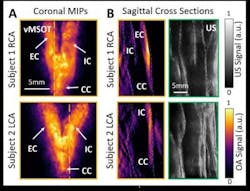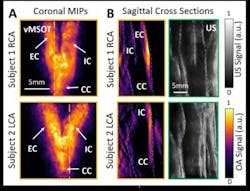Noninvasive, accurate optical imaging method assesses cardiovascular risk
A team of researchers at the Functional and Molecular Imaging Lab at the University of Zurich and the Swiss Federal Institute of Technology (both in Zurich, Switzerland) has developed a noninvasive optical imaging technique for imaging carotid arteries—the blood vessels located on the left and right side of the neck that bring oxygenated blood to the head. The method could enable earlier detection of cardiovascular disease risk, with more accuracy.
Most ischemic strokes (strokes related to a buildup of plaque in the arteries) are associated with carotid artery disease originating from the area where the arteries bifurcate (divide into branches). Common techniques such as ultrasound, computed tomography (CT), and magnetic resonance imaging (MRI) can reveal the extent of narrowing in the carotid arteries, but they are less helpful in determining the makeup of the plaque itself. This is a crucial limitation because plaque composition is associated with vulnerability to rupture, setting in motion the chain of events that leads to life-threatening strokes.
"Rapid characterization of tissue function and molecular composition is limited with these modalities, which commonly results in poor diagnostic accuracy and ineffective treatments," explains Daniel Razansky, Ph.D., director of the Functional and Molecular Imaging Lab at the University of Zurich and the Swiss Federal Institute of Technology, who is the study's senior author.
Related: Scanning fiber endoscope monitors carotid artery to track cardiovascular event risk
Razansky and colleagues studied a technique for carotid artery assessment called volumetric multispectral optoacoustic tomography (vMSOT). As with ultrasound, vMSOT is performed with a handheld device that is moved against the neck. However, vMSOT employs spectroscopy to investigate tissue at a molecular scale, providing information about the artery that is not attainable with other methods. It also can detect lipids, the pigment melanin, and other disease-related biomarkers early enough to provide better treatment options.
"Unlike most other clinical imaging modalities mainly looking at late-stage anatomical manifestations of diseases, vMSOT is capable of sensing specific molecules in tissues without administration of contrast agents," Razansky says. In carotid artery disease, he explains, vMSOT can assess the entire bifurcation area in real time and in 3D.
These images show qualitative comparison of image quality between volumetric multispectral optoacoustic tomographic (vMSOT) and B-mode ultrasound (UC) in two volunteers. The right carotid artery (RCA) and left carotid artery (LCA) are shown in a 31-year-old woman (subject 1) and in a 26-year-old woman (subject 2), respectively. vMSOT images of carotid artery bifurcation in coronal view are represented in maximum intensity projections (MIPs; a), while (b) shows vMSOT and B-mode US images of carotid bifurcation in sagittal cross-sectional views. Orange and green frames correspond to vMSOT and US images, respectively, where orange dashed lines in (a) indicate the section shown in (b). CC = common carotid, EC = external carotid, IC = internal carotid, OA = optoacoustic. (Image credit: Radiological Society of North America)
The researchers performed vMSOT imaging on 16 healthy participants and compared results with those from conventional ultrasound. The vMSOT approach was able to noninvasively and instantaneously assess the entire bifurcation area of the carotid artery in three dimensions, thus making it less prone than ultrasound to motion-related, image-blurring artifacts.
"The developed handheld vMSOT imaging approach holds promise for rapid volumetric assessment of the carotid artery and plaque vulnerability in an entirely noninvasive manner," Razansky says. "It also has the additional potential for label-free identification and assessment of clinically relevant biomarkers of carotid artery disease, which helps with early and accurate diagnosis, timely treatment planning, and monitoring."
In the future, vMSOT could be combined with ultrasound for a more comprehensive characterization of the carotid artery.
Full details of the work appear in the journal Radiology.

